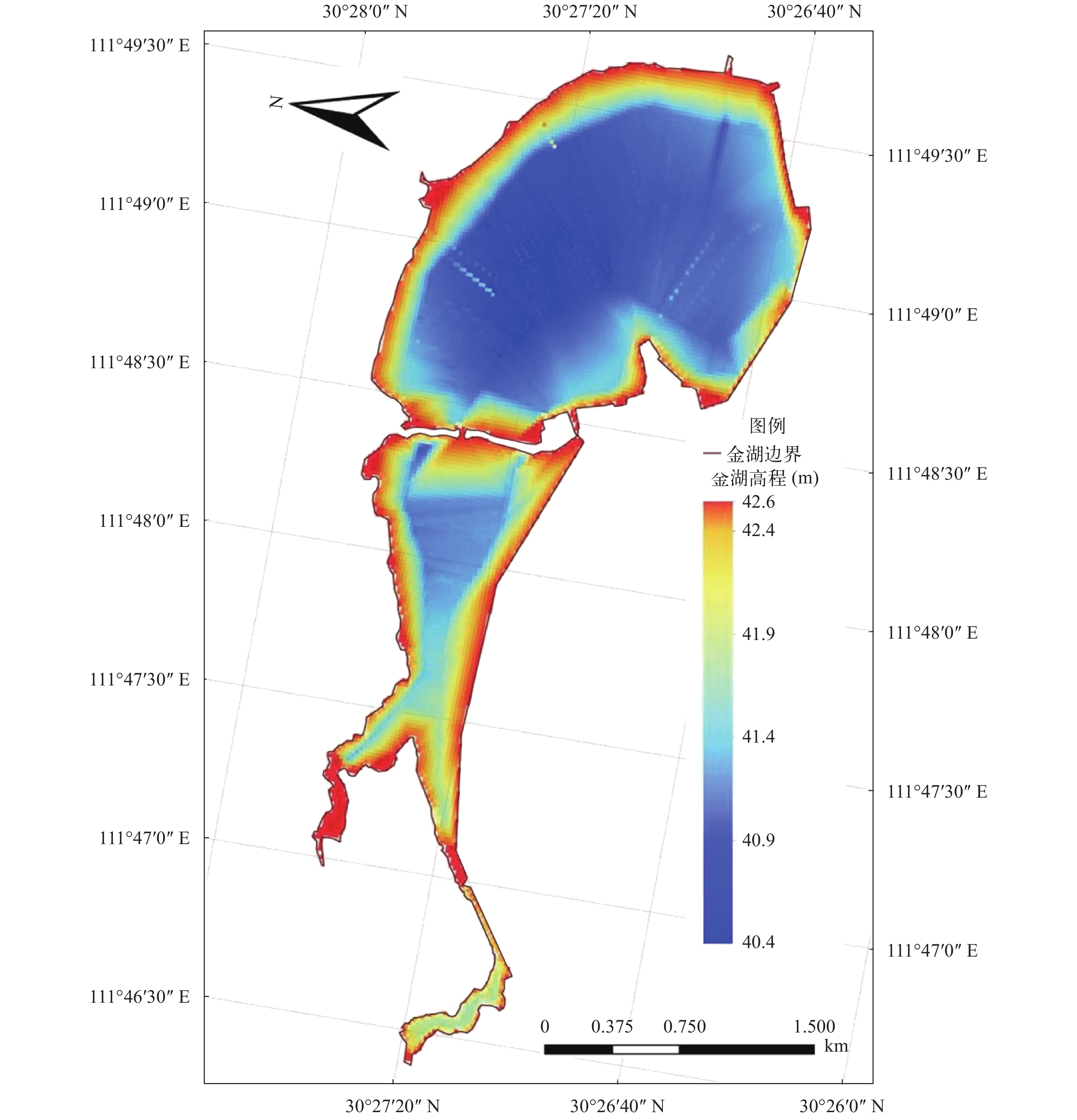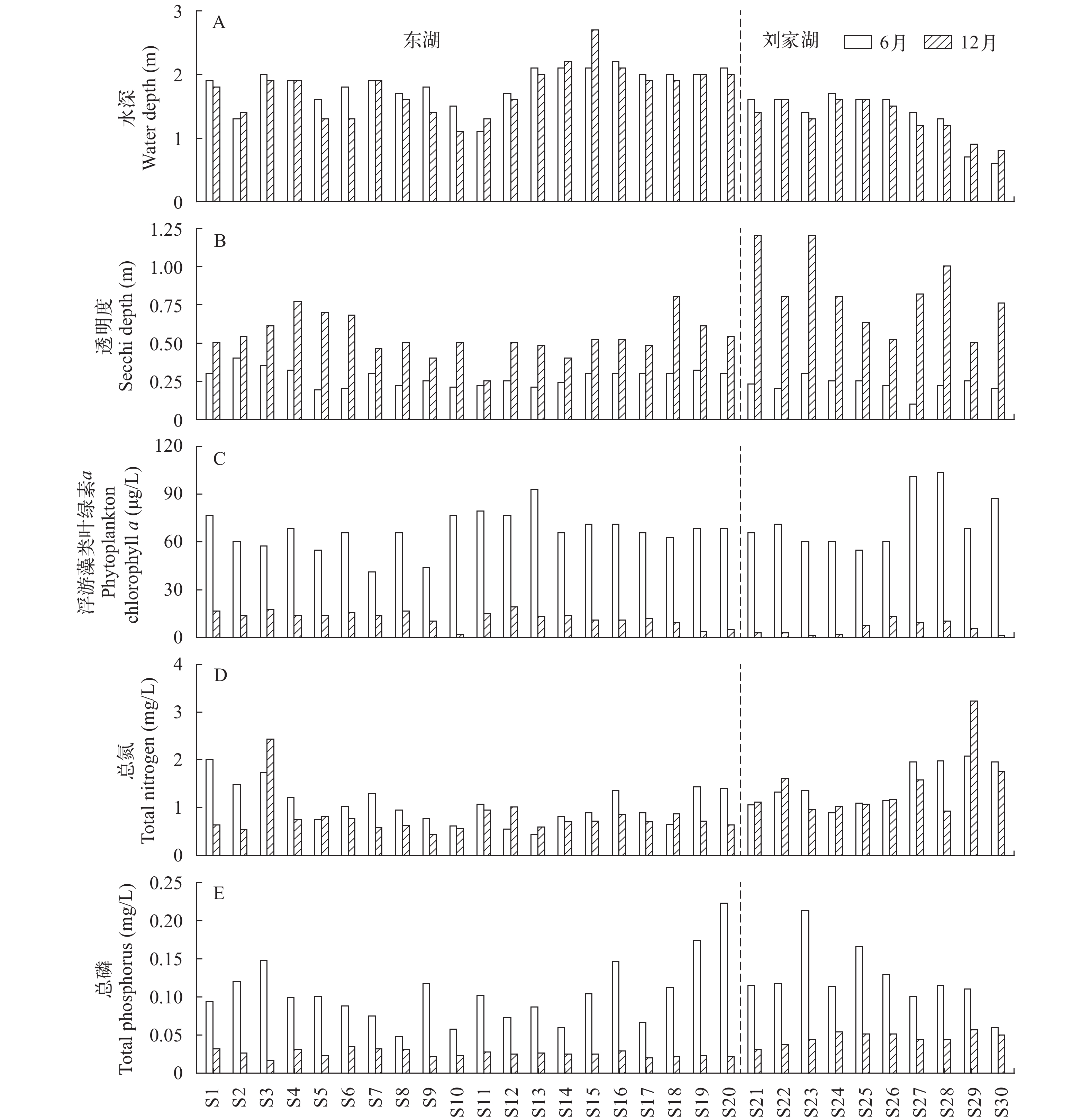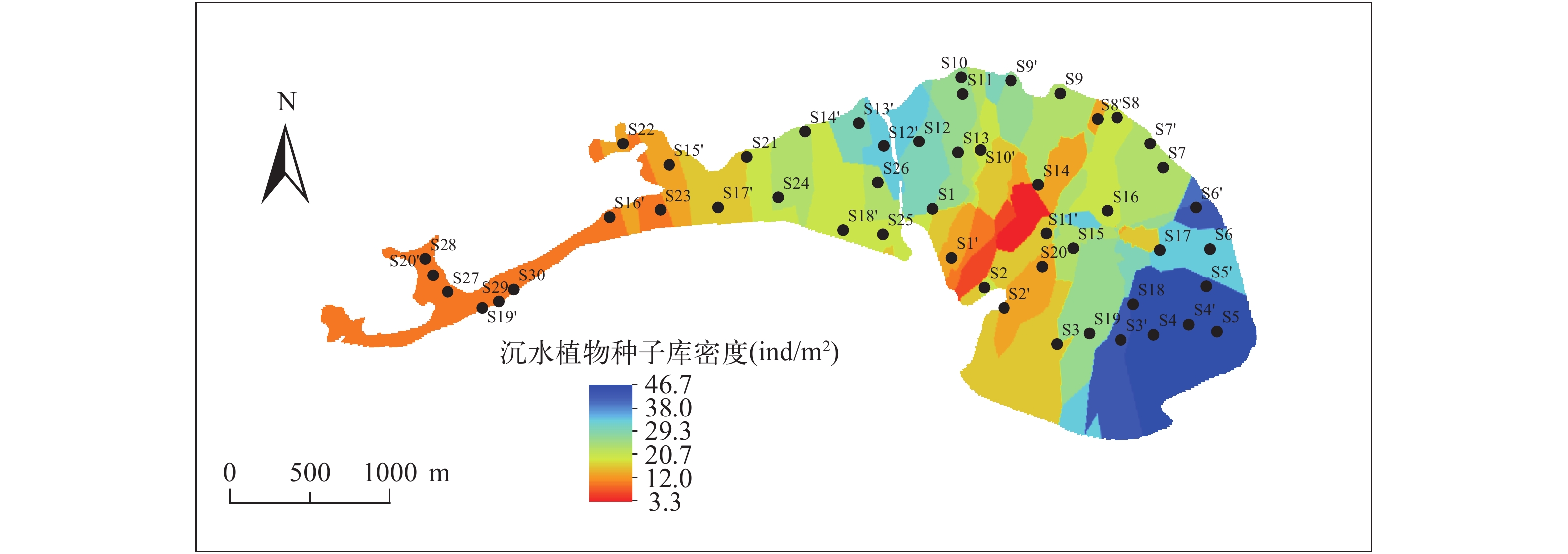INTEGRATING UNDERWATER LIGHT CONDITION AND SEED BANK TO INDICATE SUBMERSED MACROPHYTE RESTORATION ZONE: LAKE JINHU AS A CASE
-
摘要: 研究以湖北枝江金湖(由东湖和刘家湖组成)为例, 综合水下光照条件和沉水植物种子库分析, 探讨沉水植物可恢复区的判别方法。研究分别于2018年6月和12月对金湖开展了综合调查, 并在6月开展了种子库调查。结果表明, 金湖富营养化问题较严重, 6月各位点水深-透明度比值均低于沉水植物生长的阈值需求, 范围为0.13—0.25, 平均为0.17; 12月部分位点的水深-透明度比值达到了沉水植物生长的阈值需求, 范围为0.18—0.95, 平均为0.44。各位点沉水植物种子库密度范围为0—200 ind./m2, 平均为24 ind./m2。根据金湖的水下光照条件和沉水植物种子库分布情况, 结合湖底地形, 建议在冬春季透明度较高的时期降低水位, 进行沉水植物恢复工作。通过水下地形、光照条件和种子库的综合分析, 对金湖的沉水植物恢复区进行了划分, 结果显示东湖的东南部、东湖的西岸、刘家湖的西部和东岸作为沉水植物恢复区较为合适。该研究有望为湖泊沉水植物的恢复提供定量化的参考建议, 提高生态修复工程效果和降低管理成本。Abstract: Submersed macrophytes play an important role in maintaining lake ecosystem health and supporting fishery sustainability. The restoration of submersed macrophytes is an effective measure of ecological reconstruction in shallow lakes. However, assessment of the restorable zone of macrophytes is usually neglected in practical ecological restoration, resulting in low survival rates of introduced submersed macrophytes. In this study, Lake Jinhu (with two subareas, Donghu and Liujiahu), Zhijiang, Hubei Province, was studied as a case with the purpose of developing a method to assess the restoration zone of submersed macrophytes by integrating the underwater light climate and seed bank of submersed macrophytes. Two comprehensive surveys were carried out in June and December 2018. The seed bank of submersed macrophytes was analyzed in June. The ratio of Secchi depth to water depth and the seed bank distribution of submersed macrophytes were selected as the key factors to assess the restoration zones. The results suggested a serious eutrophication of Lake Jinhu. In June, the ratio of Secchi depth to water depth ranged from 0.13 to 0.25, with an average of 0.17, all much lower than the required thresholds for the regrowth of submersed macrophytes. In December, the ratio of Secchi depth to water depth ranged from 0.18 to 0.95, with an average of 0.44, mostly meeting the requirement for macrophyte growth. The density of the submersed macrophyte seeds ranged from 0 to 200 ind./m2, with an average of 24 ind./m2. Based on the underwater light climate and the spatial distribution of the seed bank, combined with the topography of the lake bottom, we suggest that the water level be lowered in winter and spring. The southeastern part of Lake Donghu, the western bank of Lake Donghu, and the eastern bank and the western part of Lake Liujiahu are zones suitable for the restoration of submersed macrophytes. The relevant findings are expected to benefit lake management in restoring submersed macrophytes by improving the efficiency of ecological restoration while lowering the cost of management.
-
Keywords:
- Submersed macrophytes /
- Underwater light climate /
- Seed bank /
- Water level regulation /
- Lake Jinhu
-
-
-
[1] Jeppesen E, Søndergaard Ma, Søndergaard Mo, et al. The structuring role of submerged macrophytes in Lakes [M]. New York: Springer-Verlag, 1998: 197-216
[2] Scheffer M. Ecology of Shallow Lakes [M]. Dordrecht; Boston: Kluwer Academic Publishers, 1998: 213-224
[3] Wang H J, Wang H Z, Liang X M, et al. Total phosphorus thresholds for regime shifts are nearly equal in subtropical and temperate shallow lakes with moderate depths and areas [J]. Freshwater Biology, 2014, 59(8): 1659-1671. doi: 10.1111/fwb.12372
[4] Moore K A, Wetzel R L. Seasonal variations in eelgrass (Zostera marina L.) responses to nutrient enrichment and reduced light availability in experimental ecosystems [J]. Journal of Experimental Marine Biology & Ecology, 2000, 244(1): 1-28.
[5] Wang H J, Wang H Z, Liang X M, et al. Macrophyte species strongly affects changes in C, N, and P stocks in shallow lakes after a regime shift from macrophyte to phytoplankton dominance [J]. Inland Waters, 2016, 6(3): 449-460. doi: 10.1080/IW-6.3.837
[6] Lauridsen T L, Jensen J P, Jeppesen E, et al. Response of submerged macrophytes in Danish lakes to nutrient loading reductions and biomanipulation [J]. Hydrobiologia, 2003, 506-509(1-3): 641-649. doi: 10.1023/B:HYDR.0000008633.17385.70
[7] Wang H Z, Wang H J, Liang X M, et al. Empirical modelling of submersed macrophytes in Yangtze lakes [J]. Ecological Modelling, 2005, 188(2): 483-491.
[8] Jeppesen E, Meerhoff M, Jacobsen B A, et al. Restoration of shallow lakes by nutrient control and biomanipulation-the successful strategy varies with lake size and climate [J]. Hydrobiologia, 2007, 581(1): 269-285. doi: 10.1007/s10750-006-0507-3
[9] Hellsten S, Riihimäki J. Effects of lake water level regulation on the dynamics of littoral vegetation in northern Finland [J]. Hydrobiologia, 1996, 340(1-3): 85-92. doi: 10.1007/BF00012738
[10] 李敦海, 杨劭, 方涛, 等. 水位调控法恢复富营养化水体沉水植物技术研究——以无锡五里湖为例 [J]. 环境科学与技术, 2008, 31(12): 59-62. doi: 10.3969/j.issn.1003-6504.2008.12.018 Li D H, Yang S, Fang T, et al. Recovery of aquatic macrophytes by use of water level regulation method in eutrophicated lakes-A case study of Wuli Lake, Wuxi City [J]. Environmental Science & Technology, 2008, 31(12): 59-62. doi: 10.3969/j.issn.1003-6504.2008.12.018
[11] 胡胜华, 史诗乐, 梅劭明, 等. 沉水植物种植工程实施后物种多样性的变化——以武汉紫阳湖为例 [J]. 绿色科技, 2019(2): 13-15 Hu S H, Shi S L, Mei S M, et al. Change of species diversity after the engineering of plant by the submerged macrophyte [J]. Journal of Green Science and Technology, 2019(2): 13-15
[12] 叶春, 刘杰, 于海婵, 等. 东太湖3种沉水植物群落区底泥种子库与幼苗库 [J]. 生态环境学报, 2008, 17(3): 1091-1095. doi: 10.3969/j.issn.1674-5906.2008.03.042 Ye C, Liu J, Yu H C, et al. General seed banks and seeding banks of 3 dominant submerged macrophyte community in east Tauhu Lake [J]. Ecology and Environment, 2008, 17(3): 1091-1095. doi: 10.3969/j.issn.1674-5906.2008.03.042
[13] Wang H J, Liang X M, Jiang P H, et al. TN:TP ratio and planktivorous fish do not affect nutrient-chlorophyll relationships in shallow lakes [J]. Freshwater Biology, 2010, 53(5): 935-944.
[14] 王海军, 王洪铸, 潘保柱, 等. 长江亚热带浅水湖群藻类浊度与非藻类浊度的变异规律 [J]. 水生生物学报, 2017, 41(2): 414-419. doi: 10.7541/2017.51 Wang H J, Wang H Z, Pan B Z, et al. Variations of algal and non-algal turbidity among the Yangtze subtropical shallow lakes [J]. Acta Hydrobiologica Sinica, 2017, 41(2): 414-419. doi: 10.7541/2017.51
[15] Canfield D E, Langeland K A, Linda S B, et al. Relations between water transparency and maximum depth of macrophyte colonization in lakes [J]. Journal of Aquatic Plant Management, 1985(23): 25-28
[16] Duarte C M, Kalff J. Littoral slope as a predictor of the maximum biomass of submerged macrophyte communities [J]. Limnology & Oceanography, 1986, 31(5): 1072-1080.
[17] Duarte C M, Kalff J, Peters R H. Patterns in biomass and cover of aquatic macrophytes in lakes [J]. Canadian Journal of Fisheries & Aquatic Sciences, 1986, 43(10): 1900-1908.
[18] Duarte C M, Kalff J. Patterns in the submerged macrophyte biomass of lakes and the importance of the scale of analysis in the interpretation [J]. Canadian Journal of Fish Aquatic Science, 1990, 47(2): 357-363. doi: 10.1139/f90-037
[19] 梁彦龄, 刘伙泉. 草型湖泊资源、环境与渔业生态学管理 [M]. 1995: 172-177 Liang Y L, Liu H Q. Resources, Environment and Fishery Ecological Management of Macrophytic Lakes [M]. 1995: 172-177
[20] Janse J H, Van D E, Aldenberg T. A model study on the stability of the macrophyte-dominated state as affected by biological factors [J]. Water Research, 1998, 32(9): 2696-2706. doi: 10.1016/S0043-1354(98)00049-9
[21] Håkanson L, Boulion V V. Empirical and dynamical models to predict the cover, biomass and production of macrophytes in lakes [J]. Ecological Modelling, 2002, 151(2): 213-243.
[22] Squires M M, Lesack L F W, Huebert D. The influence of water transparency on the distribution and abundance of macrophytes among lakes of the Mackenzie Delta, Western Canadian Arctic [J]. Freshwater Biology, 2010, 47(11): 2123-2135.




 下载:
下载:





